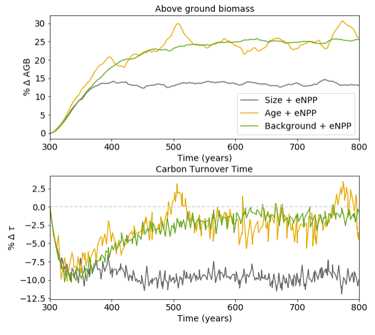The Science
Researchers used simulations to explore how size- and age-dependent mortality of trees will affect changes in forest carbon storage in response to rising CO2. They found that faster growth as a result of increased CO2 caused increases in forest biomass that were twice as large when mortality was age-dependent compared with size-dependent.
The Impact
Understanding how forests will respond to rising CO2 is critical for predicting changes in the Earth’s climate. The results of this study highlight in particular the importance of understanding large tree mortality.
Summary
Little is known about how the probability of death changes as trees get older and larger. However, as rising CO2 is expected to cause trees to grow faster, it is important that we understand whether this will lead to trees growing larger, or whether they will continue to die at the same size, but in less time. This has important implications for the amount of carbon that is stored in forest ecosystems, and how long it is stored. Researchers used simulations to explore how different mechanisms of tree mortality could affect forest carbon storage. They found that increased growth from simulated increases in CO2 caused increases in biomass that were twice as large when mortality was age-dependent compared with size-dependent. Further, they found a much larger decrease in carbon storage time when mortality was size-dependent, as trees move through their life cycles more rapidly.

Contacts (BER PM): Daniel Stover, SC-23.1, Daniel.Stover@science.doe.gov (301-903-0289)
PI Contact: Charles Koven, Lawrence Berkeley National Laboratory, cdkoven@lbl.gov
Funding
This research was supported as part of the Next Generation Ecosystem Experiments-Tropics, funded by the U.S. Department of Energy, Office of Science, Office of Biological and Environmental Research. CK also acknowledges support from the DOE Early Career Research Program. LBNL is managed and operated by the Regents of the University of California under prime contract number DE-AC02-05CH11231. RF acknowledges the support of the National Center for Atmospheric Research, which is funded by the National Science Foundation.
Publications
Needham, J. F., Chambers, J., Fisher, R., Knox, R., Koven, C. D., “Forest response to simulated elevated CO2 under alternate hypotheses of size- and age-dependent mortality.” Global Change Biology, 2020.